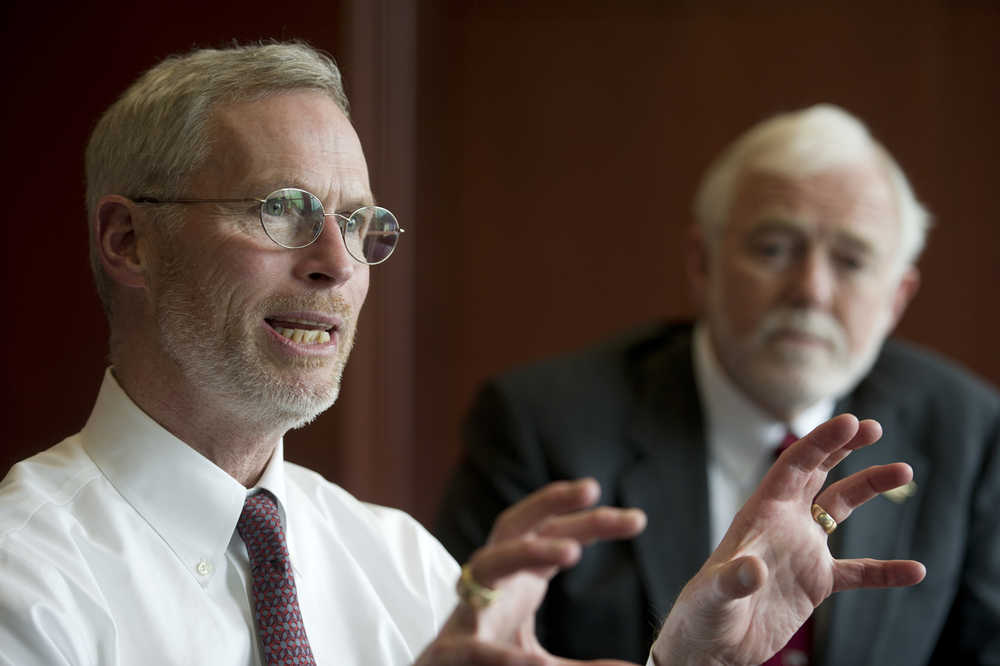It’s the dead of winter in Fairbanks, and it’s 40 below. There’s a car stranded on the side of the road, its hazard lights intermittently lighting the dense ice fog enveloping it.
Fortunately, the marooned vehicle and its driver are only metaphorical. Unfortunately, the metaphor is one that University of Alaska President Jim Johnson used to describe the position in which he found the university when he took over in July. Since then, the fog of uncertainty surrounding the UA system has only thickened.
“Our biggest enemy is uncertainty,” Johnsen told the members of the Juneau Chamber of Commerce at their weekly luncheon, and also later in an interview with the Empire Thursday afternoon. The source of that uncertainty is the Alaska Legislature.
The Legislature is currently kicking around a proposal that would cut about $50 million from the university — roughly 5 percent of its overall budget and a “very, very serious reduction,” according to Johnsen. Throw in $25 million worth of unfunded mandates, which include contractual yearly raises among other things, and Johnsen is staring down a $75 million hole in his budget.
One of the primary problems he faces is that the longer the Legislature takes to solidify its budget, the less time he has to decide how exactly the university is going to find the funds that it needs to rectify its own. And that task wouldn’t be easy given any length of time.
“We need certainty so we can commit to the kinds of decisions that we need to make,” Johnsen told chamber members before later encouraging them to write letters to their representatives in the Capitol on the university’s behalf.
Speaking to the luncheon crowd, which didn’t quite fill the ballroom of the Hangar on the Wharf, Johnsen said that he is “a glass half full kind of person.” But even the staunchest optimists would wince at the thought of having cut about 500 faculty and staff positions while simultaneously raising tuition by 10 to 15 percent. And that’s what he and the UA Board of Regents might have to do if the Legislature can’t find more money for the university during this budget cycle.
Though Johnsen is hopeful that the Legislature will provide more than the $300 million it is currently considering for the university, he and his staff have developed a priority program that will help him to make the tough budgetary calls that are ahead.
Like the factory-issued warning labels that come attached to mattresses, the program — dubbed Strategic Pathways — is essentially a guide indicating what not to cut. It sets forth the strengths of each of the universities three main campuses, located in Anchorage, Fairbanks and Juneau.
The University of Alaska’s Anchorage campus, for example, is the university system’s hub for “social and policy sciences,” according to the plan. The Fairbanks campus, on the other hand, specializes in “science and engineering” research. And the University of Alaska Southeast is the system’s base of operations for “interdisciplinary environmental” research.
“If it has to do with water, frankly, we need to have leadership in the university in this area,” Johnsen told the Empire when he and UAS Chancellor Rick Caulfield visited. This is roughly how the program is set up: It highlights the strengths of the system, so that Johnsen and other university officials know what needs to stay and what can afford to go when it comes time to lock in the tough budgetary calls.
“It’s not a plan at this point; it’s much more a framework for how to think about these tough choices moving forward,” Johnsen said to the chamber.
In the next two weeks, about 4,600 students will graduate from the University of Alaska. With the Strategic Pathways program at the ready, Johnsen is prepared to do whatever he can to make sure the number of diplomas awarded continues to grow each year — no matter how painful the budgets or how thick the proverbial fog.
“It takes a great university to build a great state, and that’s just a basic truth,” he said.

